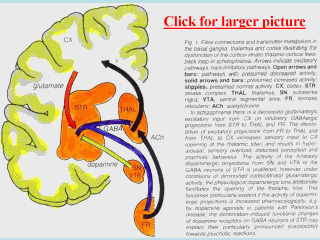 |
Another
transmitter to be implicated in the pathophysiology of schizophrenia is glutamate.
In favor of this view is the fact that various compounds that block NMDA receptor effects
(for example phencyclidine, ketamine, dizocilpine) all produce subjective affects in
humans (hallucinations, thought disorder) that closely resemble the mental state changes
in schizophrenia, suggesting that diminished glutamate thansmission might be a factor
in the disease. According to this view glutamate and DA exert excitatory and
inhibitory effects respectively on GABA-ergic striatal neurons that project to the
thalamus and constitute a sensory “gate”. Too little glutamate, or too much DA,
disables the gate, allowing uninhibited sensory input to reach the cortex. Thought
such pathways exist, there is so far little evidence for loss of glutamate function in
schizophrenia.(Fig.5,6). |
